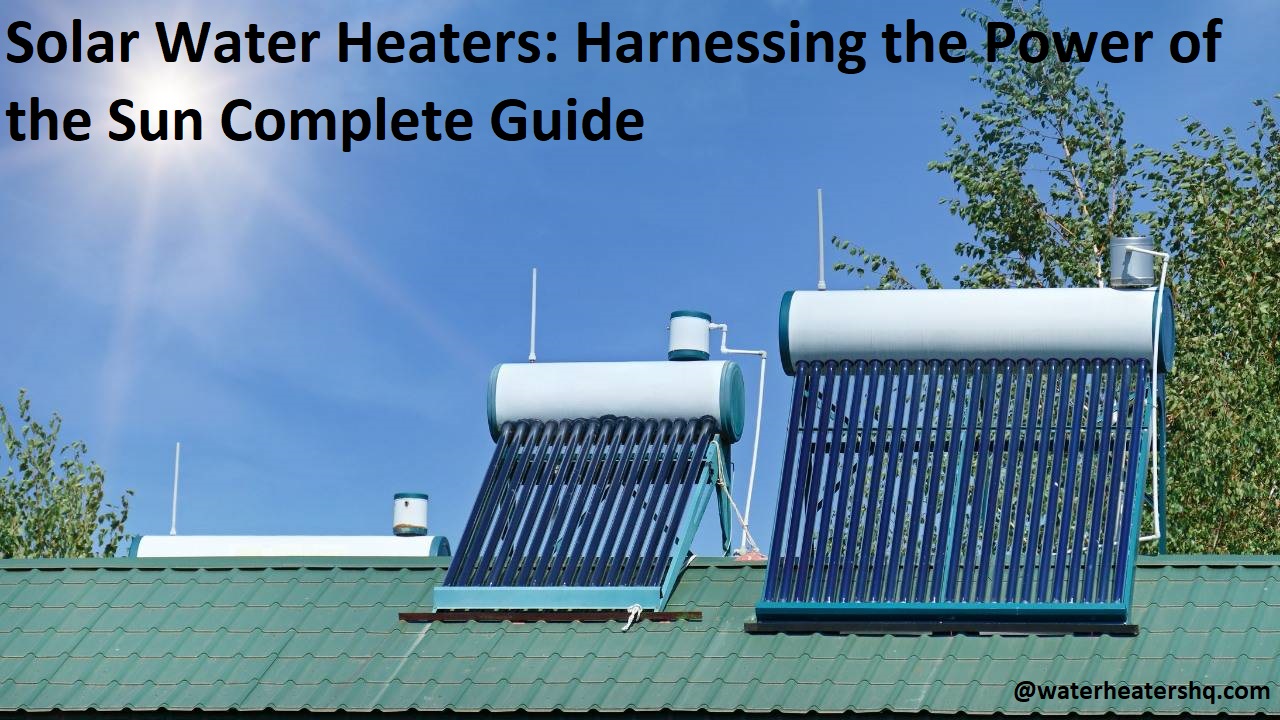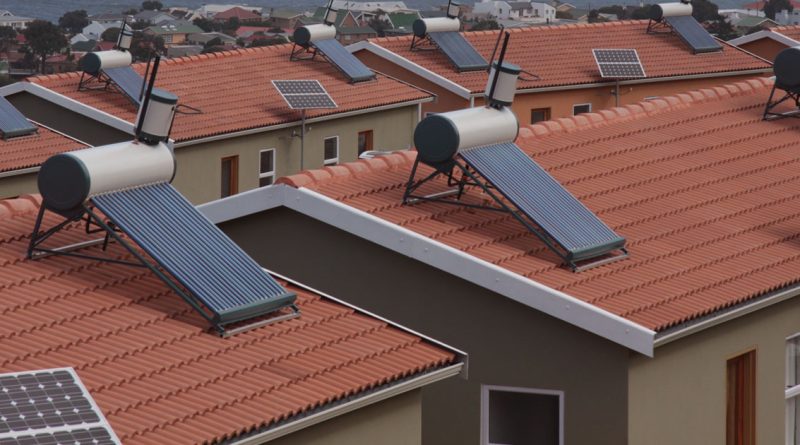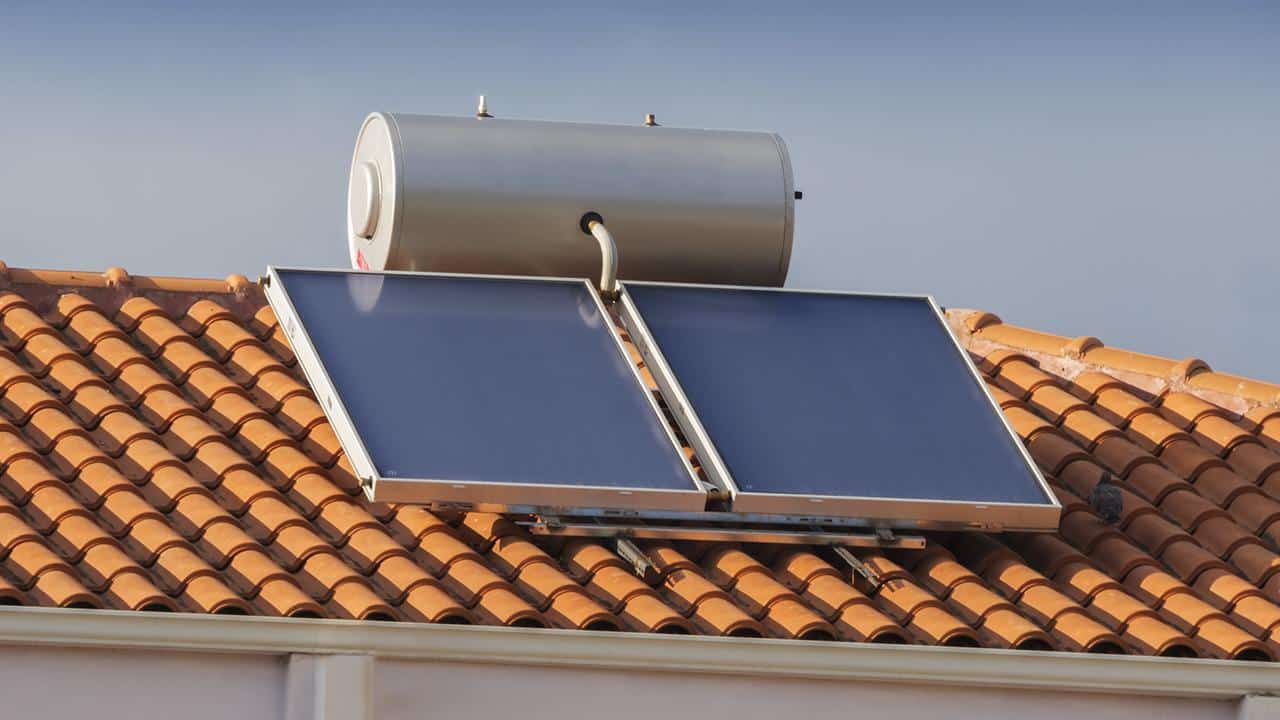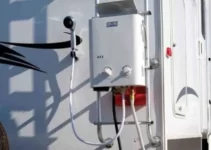Harness the power of the sun and reduce your energy bills with solar water heaters! You’ll find that installing a solar water heater is an economical and eco-friendly solution for all your hot water needs.
Get the scoop on everything you need to know about these amazing devices in this complete guide.
Solar water heaters are an efficient and cost-effective way to heat your water without relying on conventional energy sources. Using solar power, a solar water heater system absorbs the sun’s rays to produce hot water for your home.
Solar water heating systems are usually composed of three main components: collectors, pumps, and a storage tank. Collectors are installed in an area that receives direct sun exposure and they capture the sun’s heat energy. Pumps circulate the heated liquid to a storage tank where it is stored until needed. The liquid can either be a compressed antifreeze solution or simply tap water, depending on the type of system you choose.
To better understand how these systems work, it is important to become familiar with the terminology used in this field. Heat transfer fluid (HTF) is typically either an antifreeze solution or just plain tap water used to collect and transport heat from the collector(s) back to the storage tank(s). Solar radiation is measured in British thermal units per square foot (Btu/sq ft), which indicates how much power from sunlight can be obtained from one square foot of surface area when exposed directly to sunlight for one hour (peak noon reading under usual weather conditions).
In addition, incoming solar radiation also creates what’s called “thermal shock” – sudden fluctuations in temperatures which cause tubes in collectors and pipes leading from collectors to burst due to expanding materials from high temperatures followed by freezing temperatures at night resulting when heated fluid cools off abruptly as it travels into a cooler environment or space. Be sure any materials specified for your project have sufficient insulation ratings and are designed to withstand thermal shock so that their longevity and effectiveness will not be compromised over time due to such fluctuations in temperature extremes.
Brief explanation of solar water heaters
Solar water heaters make use of the solar radiation from the sun to heat up water for residential, commercial and industrial applications. By collecting the sun’s energy through a collection device such as a solar panel, these systems are able to provide hot water with minimal losses of energy. They are cost-effective, efficient and environmentally friendly. Additionally, they can be used in areas with insufficient electricity supply or other access to traditional energy sources.
Solar water heaters typically include an insulated storage tank where hot water is stored until it’s needed for use. The tank may be pressurized or unpressurized, depending on the desired output temperature and climate conditions. A solar collector is usually attached to the tank via piping or tubing and this is where the sun’s thermal energy is absorbed before transferring it into the storage lock comfortably. Generally speaking, there are two main types of solar collectors – glazed flat plate collectors and unglazed plastic collector tubes – each have their own benefits and may be used singly or in combination on any given system depending upon its location and specific requirements.

Importance of solar water heaters
A solar water heater is an efficient and cost effective way to heat water using the power of the sun. The system consists of an insulated storage tank, a water-supply pipe, and one or more solar collectors. By taking advantage of the thermal energy stored in the sun’s rays, this type of system can provide hot water for residential and commercial use year round. In addition to providing hot water, a solar water heater is also beneficial in reducing energy costs by eliminating the need for fossil fuels and reducing electricity consumption.
The most significant benefits of a solar water heating system include savings on energy bills, reduced need for energy-intensive forms of heating such as gas or oil furnaces, and improved air quality by decreasing harmful emissions from traditional sources. Additionally, many utilities are offering programs that may help finance your installation with rebates or tax credits that can offset some or all costs associated with installing a solar thermal system.
Therefore, making the switch to solar powered hot water heaters offers numerous benefits not just in terms of monetary savings but also environmental protection which should be given due consideration in today’s world when there is greater awareness about conserving our planet’s precious resources.
Types of Solar Water Heaters
Solar water heating systems come in a variety of configurations, but all leverage the benefits of solar energy to generate hot water. It is important to select the right type of system for your home to ensure optimal performance. The three main types of solar water heating systems are direct circulation systems, indirect circulation systems and thermosyphon systems.
Direct Circulation Systems: Direct circulation systems utilize pumps for circulating the pool or household water through rooftop panels containing fluid-filled tubes—called collectors—that absorb heat from the sun’s rays. The heated fluid is then passed through a heat exchanger, warming circulating water that is used in showers and other applications inside the home. Direct circulation systems are most effective when a reliable source of snow and ice melt is not needed as freezing temperatures can cause problems with the system.
Indirect Circulation Systems: Indirect circulation systems—also called antifreeze systems—circulate antifreeze solutions or other non-freezing fluids through rooftop collectors instead plain tap water like direct circulation systems do. This allows these types of solar water heating system to operate in much colder climates without fear of freezing temperatures damaging components or stopping operations altogether. Heat from sunlight heats up the non-freezing solution as it flows through collectors and then passes back into an insulated storage tank where it warms up an accompanying tank filled with domestic tap water for use around the house at any temperature desired.
Thermosyphon Systems: Thermosyphon systems rely on natural convection currents rather than pumps to circulate hot liquids throughout components within rooftop panels that collect energy from rays coming down from above. Once heated by sunlight, liquid rises to tanks which contain fresh potable drinking and washing water while cooler liquid sinks back into collection panels where it gets further heated once more before rising again inside tanks waiting below. Heating and cooling continues until either sunshine stops providing enough energy or household demands have been met with warm sanitary liquid fit for human consumption within internal pipes leading into bathroom showers, kitchen sinks and elsewhere around inhabited dwellings.
Passive Solar Water Heaters
Passive solar water heaters are an effective and economical way to utilize the sun’s energy to heat your water. This type of system is typically used in warmer climates where most of the year’s hot water needs can be met with a relatively small amount of solar energy input. Passive solar hot water systems use the sun’s energy to preheat cold water coming from your main supply, prior to it entering your existing hot-water tank or boiler.
A simple yet efficient passive system consists of solar thermal collectors, storage tanks, and associated plumbing and pumps. The collectors are typically mounted on a south-facing roof and they absorb the sun’s radiant energy which is transferred through copper pipes within them and into a tank full of water. As the tank slowly fills up with warm fluid, more pipes transfer this thermal energy into a “preheat loop” just prior to the incoming cold-water line leading into your home. The preheat loop boosts the temperature of incoming cold water before it goes through your conventional tank-type heater or boiler, thus providing a more efficient burn thus saving you money over time by reducing fuel costs associated with heating vast quantities of domestic hot water in Winter months.
Active Solar Water Heaters
Active solar water heaters use pumps to circulate water or other fluids through solar collectors and into the storage tank. The fluid in the solar collector absorbs heat energy from the sun then transfers it to the storage tank. In some cases, it is possible to make use of gravity instead of pumps where the system is designed in such a way that water can flow downwards freely powered by gravity alone. Active systems designed with pumps are typically more efficient, however, as they permit higher temperature operation due to switching on/off operation of circulation pumps. This system works especially well in areas where there is a need for domestic hot water production as well as space heating applications.
Active systems may be either direct or indirect circulation designs. Direct active systems pump potable water directly through the collectors and are ideal for temperate climates that do not risk freezing temperatures. Indirect active systems circulate a non-freezing, heat transfer fluid through the collectors and a heat exchanger transfers heat from the fluid into your domestic hot water supply between your storage tanks and outlet taps. This type of design is best suited for climates that may experience below freezing temperatures because it helps protect your system from damage due to freezing conditions.
Components of Solar Water Heaters
A solar water heater system typically consists of solar collectors, a thermosyphon storage tank and a controller. The collector is the main component, where the hot water is produced. The other major component, the storage tank, holds the hot water until it’s used. Together, these components form an effective and efficient system for harvesting free energy from the sun to heat your water.
Solar Collector: A flat plate or evacuated tube type collector is used to absorb and convert solar radiation into usable heat. Flat plate collectors are made of several steel or aluminum plates covered in a dark absorptive material that captures wavelength radiation and transfers it as heat to fluid that passes through it. On the other hand, evacuated tube collectors use vacuum-sealed tubes with two layers of glass separated by air or filled with argon gas to capture sunlight and turn it into thermal energy.
Thermosyphon Storage Tank: This type of tank stores hot water when temperatures are warm enough for solar heating and circulates cooler water as temperatures drop to maintain desired temperature levels. It functions on thermodynamics principles that involve moving heated water from one area (collector) to another (tank) through natural convection rather than powered circulation systems such as pumps.
Controller: This component manages how long your system runs each day depending on factors such as how long direct sunlight hits the panels during peak hours or changes in weather patterns (cloud cover).
Collector
Solar collectors are the primary component of solar water heating systems and come in two basic types: flat-plate collectors and evacuated tube collectors. Generally, the most suitable type of collector depends on the climate you live in, as well as other factors like use and cost.
Flat-plate collectors are the most commonly used type in residential applications. They are best suited to warmer climates, as they tend to be less efficient in cooler weather. Flat-plates consist of an insulated metal box with one or more absorber plates inside made of copper or aluminum that has been painted black to absorb maximum heat from the sun. Solar water is then heated by passing through pipes attached to these absorbers, which then circulates throughout the rest of a system before transferring it into either a storage tank or directly into appliances.
Evacuated tube collectors are made from rows of glass tubes containing one or more copper pipes along their length that work together to absorb solar thermal energy and transfer it via pipes leading out of each tube. This design makes them better suited for colder climates than flat-plate collectors due to their low conductive heat loss. They can also be used in combination with flat-plates if desired. The glass tubes also provide some UV protection, making them ideal for coastal regions where salt spray can corrode exposed metal surfaces more quickly over time than those contained within an insulated box like those found on most flat-plates.
Storage Tank
Storage tanks for solar hot water systems come in a variety of sizes and materials, but typically the most common are copper-bodied storage tanks. These copper-bodied tanks have superior heat exchange capabilities, providing the best in efficiency and performance. The tanks are also easy to install and maintain, although the price can be more expensive compared to other materials used for storage tank construction. They provide long service life and robust heat transfer qualities that make them ideal for solar hot water applications.
An additional benefit of using copper-bodied storage tanks is that they are low maintenance — they don’t require frequent cleaning or monitoring like other types of tanks do, so they can save both time and money over their lifetime. Furthermore, they are leak proof—a major consideration when it comes to indirect heating systems where anti-freeze might be used—and resistant to corrosion. They also feature a thick insulation layer that helps prevent heat loss which further adds to their energy efficient operation.
Installation of Solar Water Heaters
Installing a solar water heater can be a rewarding experience that gets you closer to your energy independence goals. Before making any changes to your existing plumbing or hot water supply, however, it’s important to make sure you the understand the different components of a solar thermal system and the specifications of the equipment you plan to install. Solar water heating systems vary widely in design and may require professional installation if they are connected to an existing hot water system.
To begin with, assess the needs of your hot water system and what type of installation will be required. The size of the panel array and whether you will use natural circulation or active pumping for a pressurized collector system will impact how much work it will take to install the components in your home.
After making any necessary improvements such as proper insulation around pipes or external facing walls, you can connect or mount the collector panels into position and tackle any necessary wiring or plumbing tasks. This is also an excellent time to check for optimal angles for orientation so that you can maximize performance from your solar thermal system.
You should also consider check valves for safety purposes and install insulated expansion tanks at high points where needed so as to maintain attention pressure in higher elevation areas of your home’s plumbing system. You may need additional technical advice if there are already components installed in previously fitted central heating systems as these might need modifying to be compatible with solar thermal applications.
Be sure to have all control valves correctly sized before connecting them with other piping items in order that sufficient flow exist between them when operational – this is particularly important when dealing with systems utilizing electricity powered pumps such as those found in ‘active pumping’ systems rather than gravity fed setups which utilise ‘natural circulation’.

Site Evaluation
To determine the best site for solar water heating, several factors should be taken into consideration. Before installing a system, it is important to know the geographical area which will influence your choice of system type and equipment used. Additionally, there are local building and energy codes in most places that govern the installation of solar water heaters.
The first step in the evaluation process is assessing the orientation of your home. An ideal configuration would have a south facing roof with a tilt of 30-60 degrees from horizontal. The more south facing roof area there is, the better because it allows for greater capture of sunlight by panels installed thereon. If you have an east or west orientation, both sun exposure and absorption will be significantly decreased resulting in less energy efficiency for your system. The total available roof space is also an important factor when calculating rooftop installation size so pay close attention to areas blocked by chimneys or vents as those won’t be useful for collecting heat.
Accessible ground space should also be evaluated because depending on the climate you live in, ground mounted systems may be more efficient alternatives to rooftop installations if they are able to capture more direct sunlight than any given section of roofing can provide in one day. Any trees or shrubs surrounding your property will affect the amount of available light due to shadows cast by foliage and must be taken into consideration when determining appropriate location and installation configuration if you opt for a ground based system instead.
Finally, local restrictions pertaining to zoning regulations must be observed when evaluating a site for solar water heating systems as some municipalities require any installations above certain costs require additional permits or fees before construction can begin so make sure you research relevant laws concerning your region before proceeding with a project!
Sizing
When it comes to solar water heaters, size matters. Not only does the size of your system determine the amount of energy it can generate, but it also affects installation and placement.
Sizing your solar water heater correctly is an essential element in designing an effective and efficient system. It’s important to consider factors such as climate, water usage needs and availability of sunshine when calculating the necessary size of a system. This can be intimidating for those who aren’t familiar with solar technology. If you are in doubt, consult with a professional solar engineer or installer for advice.
Basically, the larger your hot water tank and solar collector array, the more energy will be produced by your system each day. Knowing how much energy you need on a daily basis is crucial in determining that perfect sweet spot between optimal cost savings and desired hot water output for your household or organization’s needs.
The two main factors used to determine sizing are peak solar-hours per day and gallons (or liters) of hot water used per day. Peak sun hours refer to the maximum number of hours per day that direct sunlight is available – this will vary depending on location, season and weather patterns in general – while daily gallons refer to an estimate of how many gallons (or liters) are typically used on any given day in the home or building that the heater will service.
These two figures should combine to create an appropriate size combination that serves both financial efficiency and hot-water needs without being overly large or small; this balance helps prevent spending too much money while avoiding frustrating lagging times when waiting for hot showers or doing laundry! It’s also essential to take into account things like array layout, tilt angle experiment efficiency loss due to external factors such as sarknessing buildings blocking sun, tree cover overhangs etc. To make sure all bases are covered, professional installation by certified technicians is preferred.
Installation Process
Installing a solar water heater is a straightforward process. Generally, an installer will assess the situation and then mount the collector on the roof and attach it to the existing water system. Once everything is in place, they’ll check for proper ventilation and circulation of air, then connect the connections between the panels, storage tank and other equipment.
When installing a solar hot water heater for a residence or small business, it’s important to assess existing systems before installation begins. Tax incentives may be available depending on where you live; you should also consider whether your system will require a battery or other components to maintain its operation during inclement weather. To maximize efficiency, most products recommend using low loss headers – special pipes that reduce heat loss while providing reliable passage of heated liquid into your home.
Depending on what type of system you opt for- active or passive – a professional contractor may be needed to install electrical components such as pumps or controllers. Make sure you find someone who can safely wire such components in compliance with all local laws and codes before beginning installation! Additionally, keep in mind that many local municipalities require permit applications prior to any new construction – make sure these steps are completed before attempting any kind of installation!

Conclusion
The potential for solar water heaters is tremendous and the advantages that come with using one are countless. Their cost-effectiveness, environmental benefits, and ease of installation make them an attractive option. Additionally, with their ability to store energy from the sun and efficiently transfer it to heat water, they provide an excellent way to save money on both electricity costs as well as hot water consumption costs.
Furthermore, solar water heaters are now widely available in a variety of models for different climates and preferences; this makes it easier for homeowners to find the model that fits their needs best. When all of these factors are considered, it’s no surprise that solar water heaters have become so popular in recent years.
FAQ’S
How does a solar heater use energy from the sun to heat water?
A solar heater uses a collector, usually made of black metal, to absorb energy from the sun’s rays. The energy is then transferred to a fluid, such as water or a heat-transfer fluid, which is circulated through the collector and into a storage tank. The heated water is then ready for use.
What is the working principle of a solar water heating system?
A solar water heating system works by using a solar collector to absorb energy from the sun’s rays and transfer it to a fluid, which is then circulated through a heat exchanger to heat water for use.
What energy is produced by a solar water heater?
A solar water heater produces thermal energy, which is used to heat water for domestic or commercial use.
Is a solar water heater a device that captures sunlight to heat water?
Yes, a solar water heater is a device that captures sunlight to heat water.
How do the solar light and the solar heater work? Explain briefly.
Solar light is converted into thermal energy by the solar heater’s collector. This thermal energy is then transferred to a fluid, which is circulated through the system to heat water for use.
How is heated water used to generate electricity in a solar thermal power station?
Heated water is used to generate electricity in a solar thermal power station by producing steam, which drives a turbine that generates electricity.
What is the conclusion of a solar water heating system?
A solar water heating system is an efficient and environmentally-friendly way to heat water for domestic or commercial use.
How does a solar water heater work at night?
A solar water heater does not work at night, as there is no sunlight available to heat the collector. However, some solar water heating systems may have a backup heating system, such as an electric or gas-powered heater, to ensure hot water is always available.
What is a solar water heater also known as?
A solar water heater is also known as a solar thermal system.
What is a solar water heater an example of conversion of solar energy into?
A solar water heater is an example of the conversion of solar energy into thermal energy.
On which technology the working of solar water heater is based?
Solar water heating systems use radiation from the sun to generate heat for water, whereas solar electric systems use solar radiation to directly generate electricity.
See Also:
- Best power vent water heater
- Best propane tankless water heater
- Best solar water heater
- Best tankless water heater
- Best under sink water heater


